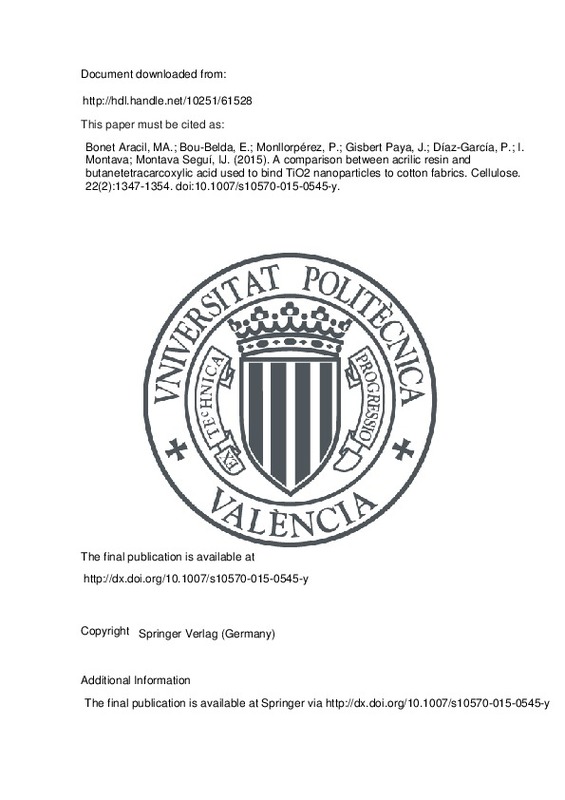Bonet MA, Capablanca L, Monllor P, Díaz P, Montava I (2012) Studying bath exhaustion as a method to apply microcapsules on fabrics. J Text Inst 103(6):629–635
Bou-Belda E, Bonet M, Monllor P, Gisbert J (2013) Variación del color de las fibras tratadas con ácidos policarboxílicos. Dyna 88:114–119
Cheema HA, El-Shafei A, Hauser PJ (2013) Conferring flame retardancy on cotton using novel halogen-free flame retardant bifunctional monomers. Carbohyd Polym. doi: 10.1016/j.carbpol.2012.09.081
[+]
Bonet MA, Capablanca L, Monllor P, Díaz P, Montava I (2012) Studying bath exhaustion as a method to apply microcapsules on fabrics. J Text Inst 103(6):629–635
Bou-Belda E, Bonet M, Monllor P, Gisbert J (2013) Variación del color de las fibras tratadas con ácidos policarboxílicos. Dyna 88:114–119
Cheema HA, El-Shafei A, Hauser PJ (2013) Conferring flame retardancy on cotton using novel halogen-free flame retardant bifunctional monomers. Carbohyd Polym. doi: 10.1016/j.carbpol.2012.09.081
Chen X, Liu Y, Shi H, Wang X, Qi K, Zhou X, Xin JH (2010) Carboxymethyl chitosan coating to block photocatalytic activity of TiO2 nanoparticles. Text Res J 80(20):2214–2222
Colleoni C, Massafra MR, Rosace G (2012) Photocatalytic properties and optical characterization of cotton fabric coated via sol–gel with noncrystalline TiO2 modified with poly(ethylene glycol). Surf Coat Technol 207:79–88
Dehadabi VA, Buschmann HJ, Gutmann JS (2012) Durable press finishing of cotton with polyamino carboxylic acids. Carbohydr Polym 89:558–563
Dong Y, Bai Z, Liu R, Zhu T (2007) Decomposition of indoor ammonia with TiO2-loaded cotton woven fabrics prepared by different textile finishing methods. Atmos Environ 41(15):3182–3192
Franklin WE, Madacsi JP, Rowland SP (1972) Recuperable durable-press fabrics. Part I: polycarboxylic acids as coreactant curing catalysts with N-methylol reagents. Text Res J 42(5):274–280
Ibrahim NA, Refaie R, Ahmed AF (2010) Novel approach for attaining cotton fabric with multi-functional properties. J Ind Text 40(1):65–82
Karimi L, Mirjalili M, Yazdansshenas ME, Nazari A (2010) Effect of nano TiO2 on self-cleaning property of crosslinking cotton fabric with succinic acid under UV irradiation. Photochem Photobiol 86:1030–1037
Kim YH, Nam CW, Choi JW, Jang J (2003) Durable antimicrobial treatment of cotton fabrics using N-(2-Hydroxy)propyl-3-trimethylammonium chitosan chloride and polycarboxylic acid. J Appl Polym Sci 88:1567–1572
Kuo Y, Su T, Kung F, Wu T (2011) A study of parameter setting and characterization of visible-light driven nitrogen-modified comercial TiO2 photocatalysts. J Hazard Mater 190:938–944
Lam YL, Kan CW, Yuen CWM (2010) Wrinkle-resistant finishing of cotton fabric with BTCA-the effect of co-catalyst. Text Res J 81(5):482–493
Martel B, Morcellet M, Ruffin D, Vinet F, Weltrowski M (2002) Capture and controlled release of fragrances by CD finished textiles. J Incl Phenom Macrocycl Chem 44(1–4):439–442
Mo SD, Ching WY (1995) Electronic and optical-properties of 3 phases of titanium-dioxide—rutile, anatase, and brookite. Phys Rev B 51(19):13023–13032
Mongkholrattanasit R, Krystufek J, Wiener J, Vikova M (2011) Dyeing, fastness, and UV protection properties of silk and wool fabrics dyed with eucalyptus leaf extract by the exhaustion process. Fibres Text East Eur 19(3):94–99
Monllor P, Capablanca L, Bonet M, Gisbert J, Díaz P, Montava I (2010) Improvement of microcapsules adhesion to fabrics. Text Res J 80(7):631–635
Montazer M, Seifollahzadeh S (2011) Enhanced self-cleaning, antibacterial and UV protection properties of nano TiO2 treated textile through enzymatic pretreatment. Photochem Photobiol 87:877–883
Montazer M, Lessan F, Moghadam MB (2012) Nano-TiO2/maleic acid/triethanol amine/sodium hypophosphite colloid on cotton to produce cross-linking and self-cleaning properties. J Text Inst 103(8):795–805
Nazari A, Montazer M, Rashidi A, Yazdanshenas M, Anary-Abbasinejad M (2009) Nano TiO2 photo-catalyst and sodium hypophosphite for crosslinking cotton with poly carboxylic acids under UV and high temperature. Appl Catal A Gen 371:10–16
Pan GT, Huang CM, Chen LC, Shiu WT (2006) Immobilitzation of TiO2 onto nonwoven fiber textile by silica sol: photocatalytic activity and duradibility studies. Environ Eng Manag J 16(6):413–420
Peng H, Yang CQ, Wang X, Wang S (2012) The combination of itaconic acid and sodium hypophosphite as a new cross-linking system for cotton. Ind Eng Chem Res 51:11301–11311
Qu Q, Geng H, Peng R, Cui Q, Gu X, Li F, Wang M (2010) Chemically binding carboxylic acids onto TiO2 nanoparticles with adjustable coverage by solvothermal strategy. Langmuir 26(12):9539–9546
Sarier N, Onder E (2012) Organic phase change materials and their textile applications: an overview. Thermochim Acta 540:7–60
Socrates G (1997) Infrared caharcteristic group frequencies. Wiley, Hoboken
Specosa MM, Garcíac JJ, Torneselloc J, Marina P, Della Vecchiab M, Defain Tesorierob MV, Hermida LG (2010) Microencapsulated citronella oil for mosquito repellent finishing of cotton textiles. Trans R Soc Trop Med Hyg 104(10):653–658
Sricharussin W, Ryo-Aree W, Intasen W, Poungraksakirt S (2004) Effect of boric acid and BTCA on tensile strength loss of finished cotton fabrics. Text Res J 74(6):475–480
Sunderesan K, Sivakumar A, Vigneswaran C, Ramachandran T (2011) Influence of nano titanium dioxide finish, prepared by sol-gel technique, on the ultraviolet, antimicrobial, and self-cleaning characteristics of cotton fabrics. J Ind Text 41(3):259–277
Trask-Morrell BJ, Andrews BAK (1994) Thermoanalytical study of durable press reactant levels on cotton fabrics. Part I: nonformaldehyde polycarboxylic acids. Text Res J 64(12):729–736
Wang CX, Chen SL (2006) Surface treatment of cotton using β-cyclodextrins sol–gel method. Appl Surf Sci 252(18):6348–6352
Wanga CC, Chen CC (2005) Physical properties of the crosslinked cellulose catalyzed with nanotitanium dioxide under UV irradiation and electronic field. Appl Catal A Gen 293:171–179
Wu D, Long M, Zhou J, Cai W, Zhu X, Chen C, Wu Y (2009) Synthesis and characterization of self-cleaning cotton fabrics modified by TiO2 through a facile approach. Surf Coat Tech 203:3728–3733
Yang CQ (2001) FTIR Spectroscopy study of ester crosslinking of cotton cellulose catalyzed by sodium hypophosphite. Text Res J 71(3):201–206
Yang H, Zhu S (2004) Studying the mechanisms of titanium dioxide as ultraviolet bloking additive for films and fabrics by an improved scheme. J Appl Polym Sci 92:3201–3210
[-]







![[Cerrado]](/themes/UPV/images/candado.png)


